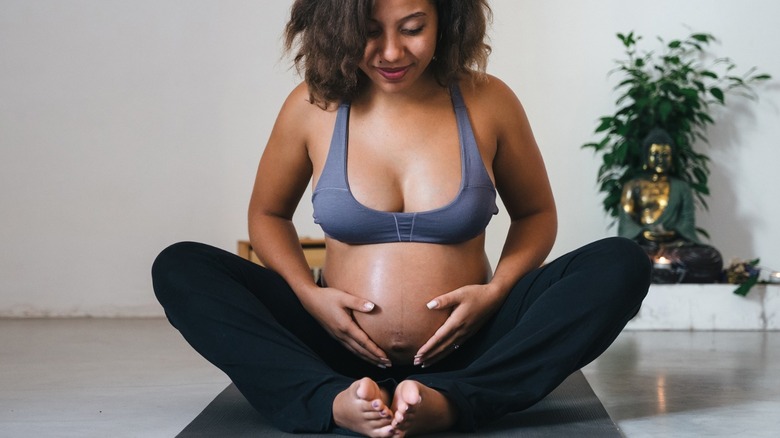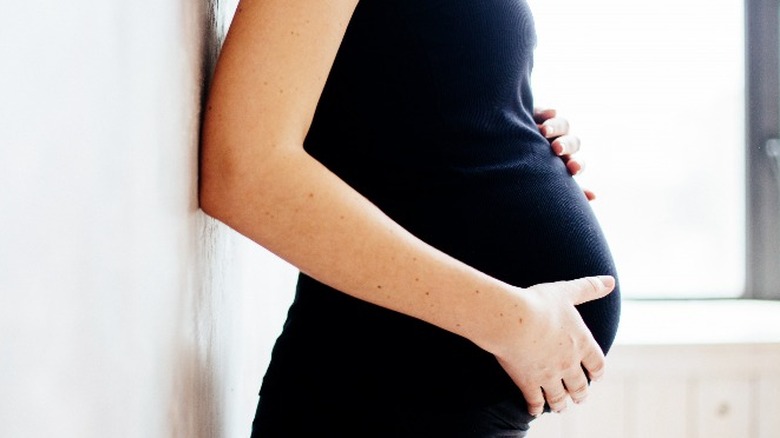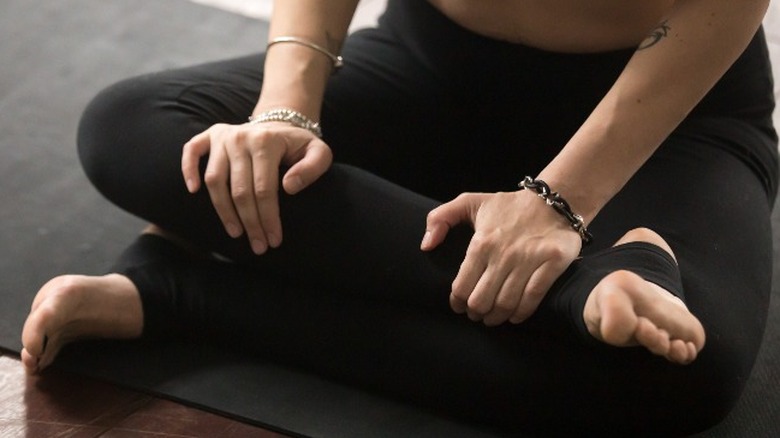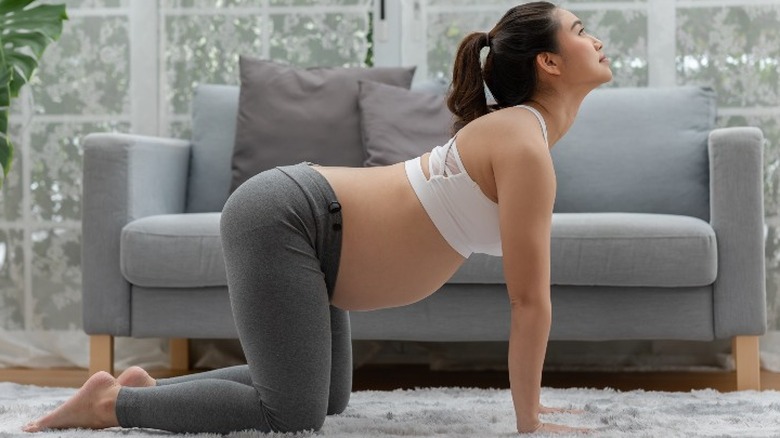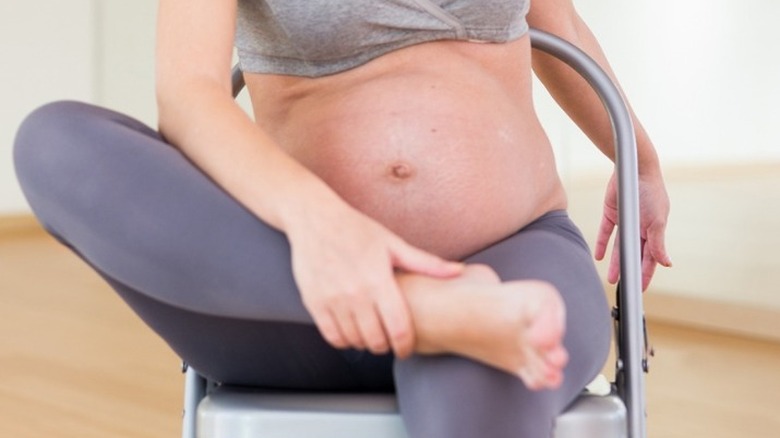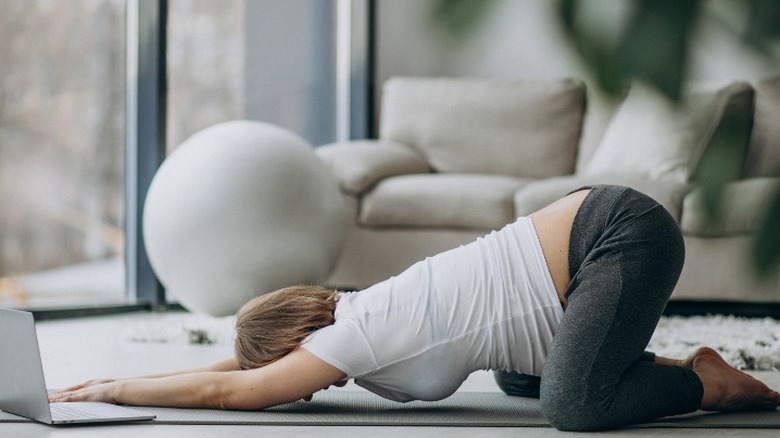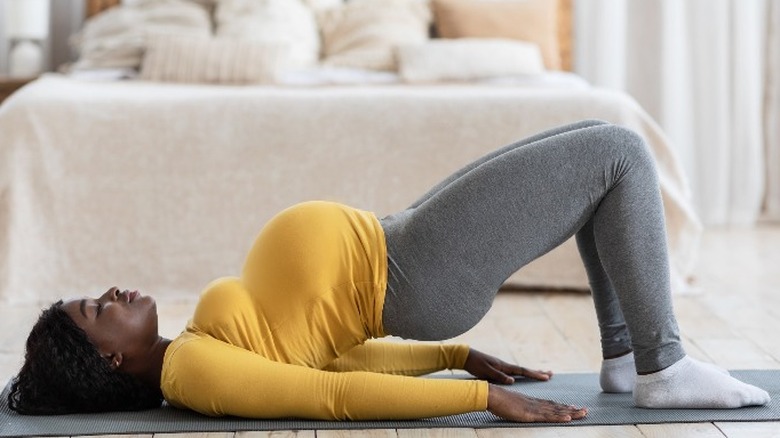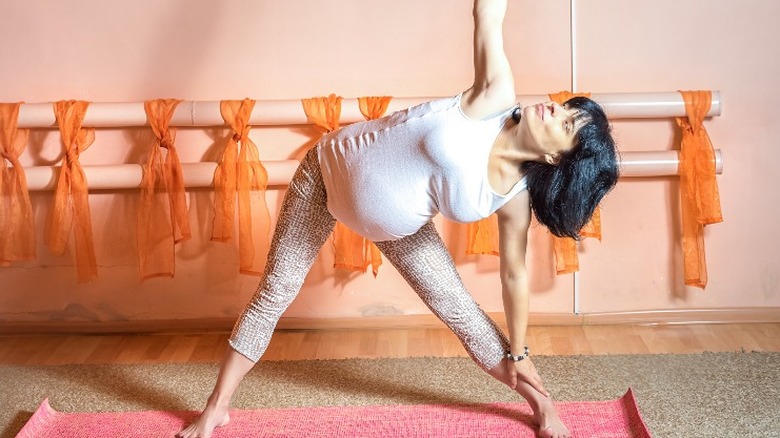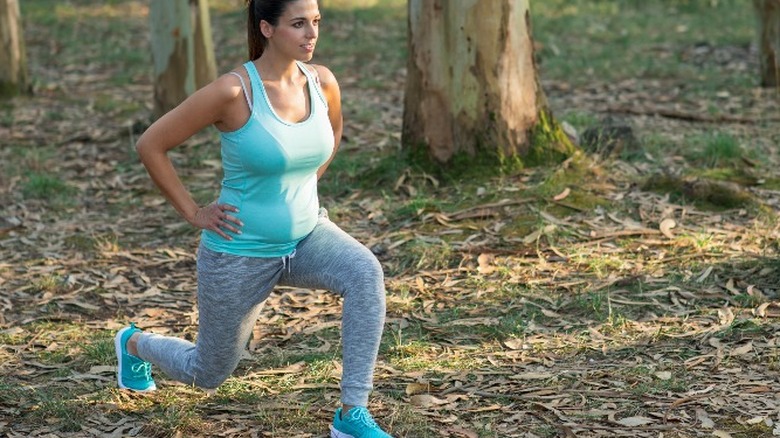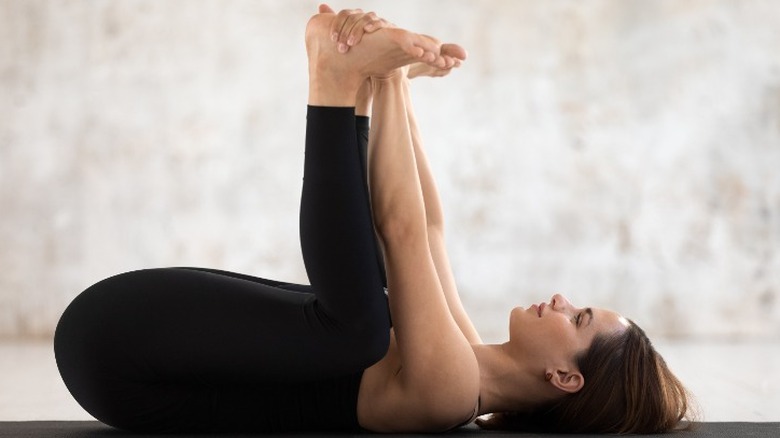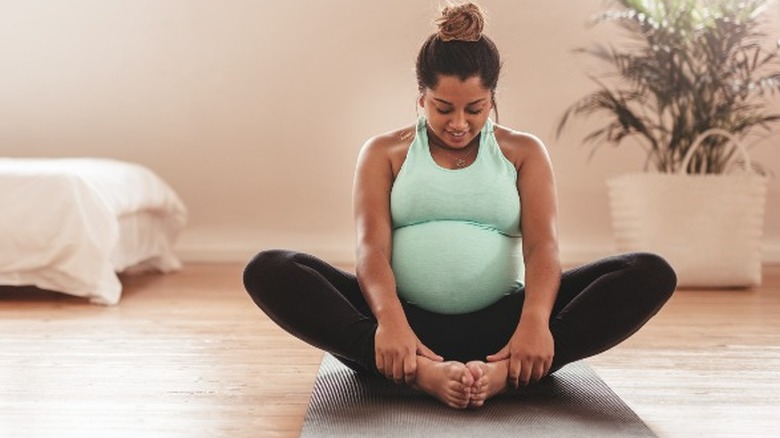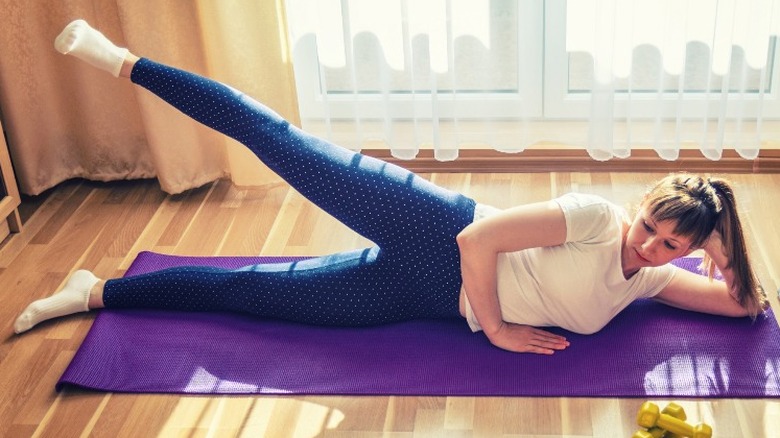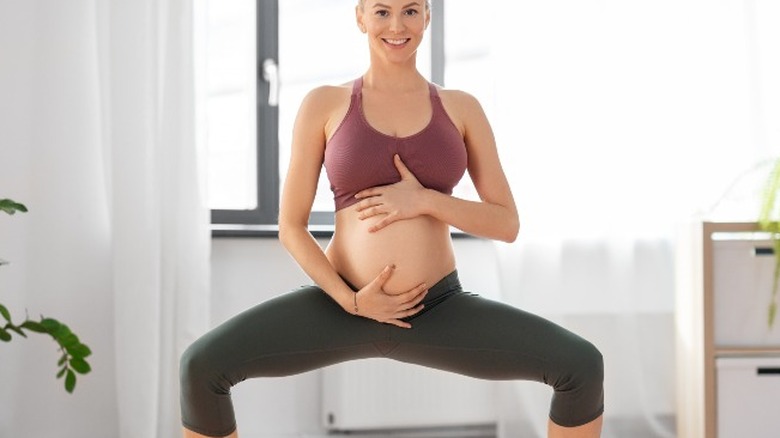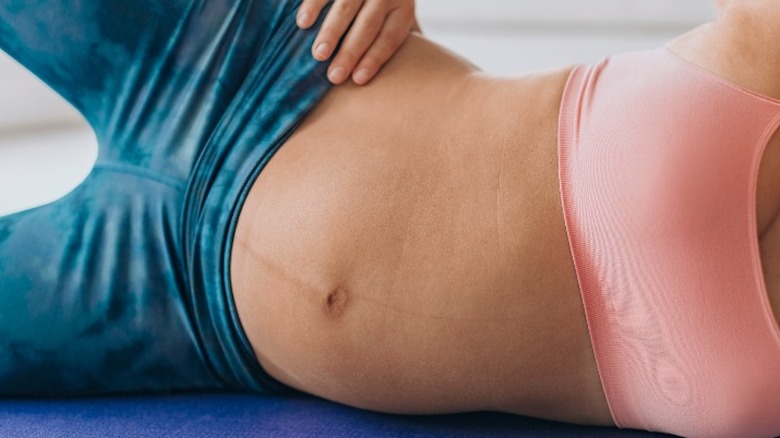The Best Exercises To Help Ease Hip Pain During Pregnancy
Pregnancy is often a special time in a woman's life — full of blissful preparation and anticipation of her happy bundle of joy. However, it rarely comes without some form of discomfort. Research in BMC Pregnancy and Childbirth shows that about half of all pregnant women experience pelvic girdle pain (PGP), or pain felt around the pelvic joints, hips, lower back, and thighs. The data also says that between 25-30% of pregnant women experience more severe PGP pain.
According to the American Pregnancy Association, hip pain is one of the most common symptoms women report during pregnancy. Most often, the pain worsens during the second and third trimesters when more weight increases pressure on the sciatic nerve. Round ligament pain is another cause of discomfort in the hips as the ligament stretches during pregnancy (per the American Pregnancy Association).
Also, the body releases special hormones during pregnancy that cause the body's connective tissues, such as the ligaments and joints in the pelvis, to relax and loosen (via the American Pregnancy Association). This makes it possible for the baby to pass through the hips during labor and delivery. Unfortunately, the increased flexibility in the bones and joints can also cause soreness and pain in the hips (per Medical News Today).
Fortunately, there are some movements and stretches that can help pregnant women who are suffering from hip pain. Here are 13 exercises to ask your doctor about that may alleviate some of your pregnancy hip discomfort.
Standing pelvic tilt
The shifting center of gravity and increased weight during pregnancy can cause posture changes, which may contribute to hip pain (per The Bump). Poor posture often leads to an anterior pelvic tilt during pregnancy, causing muscle tightness and pelvic pain, according to What to Expect.
The standing pelvic tilt exercise can help strengthen the core and back, which may ease pain in the hips and pelvis during pregnancy. A research article published in the American Association of Occupational Health Nursing shared that the pelvic tilt relieves stress on the lower back, improving posture and pain levels in the pelvis. Ask your doctor about this stretch to see if it may be helpful for you.
According to the Mayo Clinic, you perform a standing pelvic tilt by standing straight with your feet in line with your shoulders and your back against a wall. Then, attempt to push the small of your lower back towards the wall, and have them touch if possible. Hold your body in this position for several seconds before releasing and returning to your original stance.
Fire log pose
Sciatic nerve pain, also called sciatica, can be the culprit of hip and pelvis discomfort for many expecting women (per WebMD). As you gain weight throughout your pregnancy, there is more pressure on muscles and joints, which can compress the sciatic nerve. It's most common during the third trimester, but it can also occur earlier for some pregnant women (via What to Expect).
The fire log pose is a yoga stretch that focuses on the outer hips, which can help with sciatic nerve pain (per Yoga Journal). To perform this stretch, sit cross-legged in a comfortable position on a yoga mat or blanket on the floor. Take one of your ankles and stack it over the knee of the opposite leg with your foot slightly forward off your knee. Flex your feet, so they line up with the edge of your yoga mat. In this position, you should already feel a stretch in your hips.
If you can, place the opposite knee over the other ankle, so they are touching. But if that's too difficult, you can try putting a pillow between the knee and ankle. Sit tall while not folding forward, and hold this position as you breathe deeply. Then, switch legs and repeat.
Cat-cow stretch
The cat-cow stretch is actually a combination of two yoga poses designed to strengthen the back and abdominal muscles, relieve pressure on the spine, and improve posture (via the Yoga Journal). According to the American Pregnancy Association, strengthening the muscles in the back and abdomen and focusing on better posture can help support the added weight and pressure of pregnancy, which will likely reduce hip pain.
To enjoy the benefits of this exercise, start in a tabletop position on your hands and knees with a neutral spine on a yoga mat. Then, move into cat pose by shifting your pelvis forward while gently rounding your back and dropping your head between your arms. After holding that position for several seconds, transition into cow pose (as shown by Yoga Journal) by reversing your pelvis tilt backward, slowly arching your back, and lifting your chin upward.
As with any exercise during pregnancy, it's crucial to speak to your doctor about this stretch and use modifications when necessary. You should discuss your limits and whether these poses are beneficial for your pain management needs.
Modified pigeon pose
A study published in The Journal of Alternative and Complementary Medicine showed that practicing yoga during pregnancy can help reduce the intensity of lumbopelvic pain, which includes hip and lower back pain. Pigeon pose is a common yoga position that helps to open the hips and ease pain in the lower back and hips (per Healthline). Along with other yoga poses, a modified form of pigeon pose can be beneficial for expectant mothers who have tightness or pain in the hips.
While classic pigeon pose is done on the floor, modified pigeon pose is done in a chair and is considered safe for pregnant women in their second and third trimesters (via BabyCenter). While sitting in a chair, gently raise your left foot and place it over your right thigh. Rest your hands over your left leg with your palms facing upwards.
Then, with your neck and spine in alignment, gently bend forward, so your elbows are now resting over your left leg. Hold this position for a few seconds while breathing deeply. Return to the original position with both feet flat on the floor before switching to the other leg and repeating the stretch on that side.
Child's pose
A gentle stretch that can help increase flexibility in the hips is child's pose (via Yoga Journal). This popular yoga position is often done as a transitional pose between more challenging stretches and movements. However, it provides several benefits on its own. Child's pose helps to alleviate tension, open the hips, lengthen the spine, and stretch the thighs (per WebMD).
Bring yourself to a kneeling position on a yoga mat and sit on your heels. Separate your knees and fold forward to bring your torso and head to your mat. Walk your hands toward the front of the mat until they are stretched out with palms facing the floor. Hold this position while taking slow, deep breaths and releasing any tension in your jaw, shoulders, back, and legs. When finished, inhale and walk your hands back up towards your legs as you lift your torso up to a kneeling position.
While you should talk to your healthcare provider about this pose, there are possible modifications that can help you perform this stretch as your pregnancy progresses, such as separating your knees further to avoid too much pressure on your growing belly.
Bridge stretch
According to the American Pregnancy Association, posture changes occur during pregnancy due to added pressure on the pelvis. An anterior pelvic tilt can result in hip pain and pressure for pregnant women as their posture shifts to accommodate the extra weight.
Bridges are an easy exercise that activates the glutes and builds core strength, which can actually improve posture (via Today). Moreover, working the lower body, including the glutes, can help to alleviate pelvic and back pain in pregnant women (via What to Expect).
To perform a bridge stretch, lay on your back with your knees bent and feet flat on the ground in line with your hips, as demonstrated by the National Academy of Sports Medicine. Raise your hips up while keeping your knees hip distance apart and arms down at your sides. Squeeze your glutes tightly as you hold this position for about two seconds before releasing and returning your hips to the floor. Try to keep from arching your back or putting strain on your neck during this exercise. When you raise your hips, your back should be in a straight line from your shoulders to your knees.
Triangle pose
Another yoga position that helps to stretch the hips and strengthen the legs is triangle pose, a foundational standing pose that involves creating a triangle with your arms, legs, and torso. Stretching the hips offers several benefits, such as improving mobility, reducing hip pain, and relieving tightness (per Self).
Triangle pose starts with standing straight with your legs about three feet apart (via Yoga Journal). Raise your arms out to your sides, so they are about the height of your shoulders and parallel to the floor. Carefully turn your left foot out to a 90-degree angle with your body and rotate your thigh to align with your foot. Then, extend your left hand out while bending at the hip joint toward your left thigh. Rest your hand on your thigh to form a triangle as you lengthen and strengthen your leg and hip muscles. Hold there for a few seconds before recentering and reversing to the other side.
While you can reach further than your thigh, listen to your body and only go as far as what feels comfortable for you. Women may want to modify this pose during pregnancy to help maintain balance, especially in the second and third trimesters. Although many studies, including this study in Obstetrics & Gynecology, show evidence that yoga is safe during pregnancy, you should always talk to your doctor before starting a prenatal exercise routine.
Lunge
A lunge is an excellent exercise that helps to strengthen several muscles in the legs, including the quadriceps, gluteals, hamstrings, and calves (per Healthline). As shared by What to Expect, building lower body strength can actually help counter some common issues that cause hip, pelvic, and lower back pain during pregnancy.
According to the National Academy of Sports Medicine, lunges and other foundational movements are considered safe during pregnancy and can help with maintaining good posture and building lower body strength. Improving posture and balance are some ways to offset the pressure and weight of a growing baby (per Medical News Today).
To complete a lunge exercise, stand with your feet hip-width apart. Step forward with your right foot, making sure your foot is directly in line with your right knee. Then, lower your body by bending both knees. Be careful not to let your right knee go past your toes to keep your torso straight and neutral. Keep most of your weight on your right heel as you press forward. Return to a standing position, switch legs, and repeat on the other side.
If you find that you have issues with balance during this movement, you may want to hold on to a chair or other fixed object to keep you steady. As always, talk to your healthcare practitioner to see if this exercise is safe for you.
Happy baby pose
A fun yoga position that targets the back and hips is the happy baby pose (via Yoga Journal). This stretch helps with hip mobility without bearing any weight on your already overworked joints during pregnancy.
Although some doctors may recommend avoiding yoga poses that require lying on your back, an article published in Reuters shared research that found no adverse effects from these types of positions, including the happy baby pose. However, speak to your healthcare provider to see if they are appropriate for your prenatal exercise routine.
To perform happy baby pose, lie flat on your back. Keep your head against the mat while bending your knees inward toward your chest and the soles of your feet facing upward. Reach for your feet and wrap your hands around the soles of your feet. Then, spread your knees apart while flexing your heels and gently rock your body from side to side. If you cannot comfortably reach your feet, try using a yoga band wrapped around your feet to still get the benefits of this stretch.
Bound angle stretch
For pregnant women experiencing hip pain and tightness in the lower back, the bound angle pose is a good stretch for opening the hips, strengthening core muscles, and improving posture (per Yoga Journal). The American Pregnancy Association shares that both strengthening abdominal muscles and improving posture can help to reduce hip pain during pregnancy.
To try the bound angle stretch, start by sitting on the floor or a yoga mat with your legs stretched out in front of you and your back straight (per The Yoga Institute). Focus on your posture and keeping your spine and neck aligned with your hips. Bend both knees and let them fall open to the sides of your yoga mat. Then, use your hands to align the soles of your feet and hold your ankles as you lift your torso through your chest. Hold this position and breath deeply before releasing and returning to a relaxed position.
Hip abductor (side leg raise)
Hip abductor exercises, or side leg raises, focus on strengthening the hip abductor muscles, which can cause pain in and around the hips if they become weak (per Medical News Today). This muscle group plays a significant role in mobility and leg control, which are essential for expectant mothers to reap the benefits of staying active during pregnancy (via What to Expect). Also, improved lower body strength can better support the weight of your growing baby, which may provide some hip pain relief.
If you don't have balance issues, you can try a standing abduction exercise (via OncoLink). Standing straight with your legs about shoulder-width apart, keep your left leg planted on the floor while you raise your right leg to the side. Repeat this movement several times before switching to the other leg. You can try bending your supporting leg slightly to help with balance issues or use a chair to keep steady if you're finding it difficult.
There is also a side-lying abduction exercise (via Healthline), which involves the same motion while lying on your side rather than standing up. This may be easier for pregnant women who need a little more stability. Just be sure not to lean forward or back while performing this movement.
Goddess squat
The goddess squat, or goddess pose, is a yoga position considered safe during the second and third trimesters that can help with balance and overall muscle strength (per BabyCenter). According to Women's Health, goddess squats target and strengthen the legs and glutes, which may reduce prenatal hip pain symptoms by supporting increased pregnancy weight (per What to Expect). In addition, exercising during pregnancy can prevent excessive weight gain, which will limit the pressure on your hips (via Medical News Today).
Start the goddess pose by standing comfortably with your legs apart and arms by your sides. Focus on your pelvic floor muscles and draw them in. Then, inhale deeply as you stretch your arms up above your head. As you exhale, bend your knees while keeping them in line with your toes. At the same time, bend your arms at the elbow and bring them down with your hands open and fingers stretched apart. Squat into that position before returning to standing as you inhale (via BabyCenter).
Side-lying clamshell exercise
According to a study published in the Journal of Orthopaedic & Sports Physical Therapy (JOSPT), the clamshell exercise is an excellent way to target the gluteal muscles. While the study was meant to identify exercises to help those with abnormal hip rotations, it shows that the clamshell exercise significantly activated the gluteal hip abductors, which can benefit others as well.
Why is this helpful? The clamshell exercise can strengthen the hips and provide physical therapy benefits to those with back pain and sciatica nerve pain (via Healthline). The clamshell focuses on improving the strength of the gluteus medius, which plays a significant role in stabilizing the pelvis.
Try the clamshell by lying on your side with your knees bent at a 45-degree angle and your legs stacked. Place your bottom arm under your head for support with your other hand on your hip. While keeping your feet touching at the heel, raise your knee upward without shifting your hips or rocking your body. Your bottom leg should remain on the floor and not lift up as you move the top leg up and down. Repeat the movement several times before switching to the other side.
Be sure to talk to your doctor before including the clamshell or any other physical activity in your prenatal routine. It's important to ensure your fitness level can support exercise during pregnancy.

